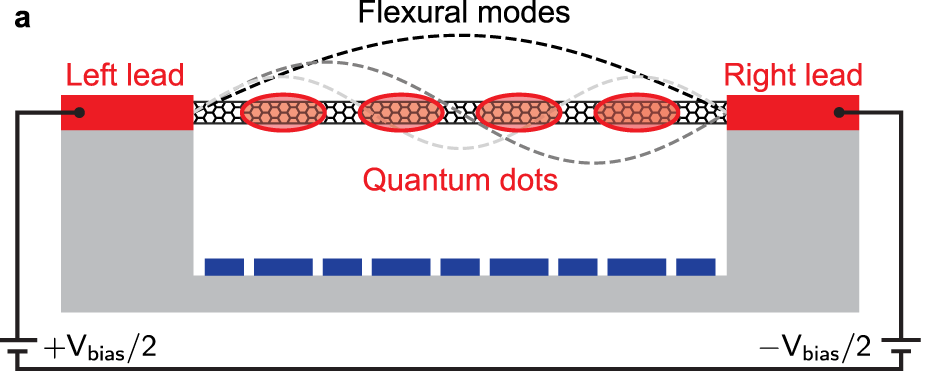Correlated electron-phonon physics in nanotube quantum simulators
In the search for novel materials, the simulation of quantum matter is an extremely demanding computational task, which is expected to profit substantially from the surge of quantum technologies. Quantum algorithms for programmable quantum computers offer the most flexible approaches, but tailor-made quantum simulators are particularly well suited for large-scale simulations. For instance, tremendous efforts have been made to simulate graphene-like materials using synthetic quantum systems, such as artificial semiconductor lattices, cold atoms in optical lattices, or photonic crystals.
However, in order to reach the complexity of real materials, quantum simulators need more controllable degrees of freedom. Specifically, apart from electrons, also phonons are fundamental ingredients of quantum materials, and the ubiquitous electron-phonon interaction is a central issue in condensed matter and material physics. Many important and interesting phenomena are rooted in this interaction, dating back to the seminal work on Bardeen-Cooper-Schrieffer superconductivity, or charge-density wave (CDW) order induced by the Peierls instability.
There are quantum simulation platforms which themselves consist of electrons and phonons and hence appear to be ideally suited for the study of quantum materials. One such platform is quantum dots defined on a suspended carbon nanotube, where the phononic degrees of freedom are naturally provided by the flexural modes of the nanotube and the electrons localized in quantum dots interact with the mechanical modes electrostatically.
Many parameters of such a system can be tuned either at the fabrication stage or during the experiments. Especially, the short and controllable separation between the nanotube and gates allows a very large electron-phonon coupling strength. The nonlocal nature of phonon modes in this system also provides opportunities to explore physics beyond archetypal and simplified models. Although currently this kind of system is limited in size, advances in nanofabrication make it promising to fabricate a carbon nanotube with many quantum dots. On the other hand, even with the current small system, there are many interesting physical and technological phenomena associated, such as the phonon-induced pairing and the nanomechanical qubit.
One particular feature of this system is that the quantum dot setup can barely be viewed as an isolated quantum system, but rather as an open quantum system which is coupled to a fermionic environment via leads. It would be most interesting to be able to describe the transport and driving in this challenging system with many electronic and phononic degrees of freedom. In this respect, while the open system properties of single and double dots coupled to a single phonon mode has been studied extensively, the case of multiple dots has not been considered.

Now, a team of researchers has studied 1 the correlated physics in a nanotube quantum simulator with four spin-polarized quantum dots coupled to the leads. The researchers have developed methods to attack the challenge of theoretically describing this electron-phonon open quantum system problem. These new methods allow the team to study transport through the device, a great opportunity to detect important system properties.
One of these properties is that, upon increasing the electron-phonon coupling strength, a Peierls instability turns the system into an insulator with an alternating CDW pattern of empty and occupied quantum dots. This would be a consequence of the competition between electronic Coulomb repulsive interactions and phonon-induced attractive interactions. Although such a CDW order is also present without coupling the system to leads, observing it as a steady state property in open quantum system provides a feasible route for the preparation as well as the detection of this intriguing phenomenon.
These results shall largely stimulate the experimental advances in the study and detection of correlated electron-phonon physics in a nanotube quantum simulator. First, because the proposed setup can be accessed via current techniques in nanofabrication. And second, the high tunability of different parameters make it possible to directly observe and detect the predicted phonon-induced correlated physics and transport behaviour.
Author: César Tomé López is a science writer and the editor of Mapping Ignorance
Disclaimer: Parts of this article may have been copied verbatim or almost verbatim from the referenced research paper/s.
References
- Zhang, L., Bhattacharya, U., Bachtold, A., Forstner, S., Lewenstein, M., Pistolesi, F. & Grass, T. (2023) Steady-state Peierls transition in nanotube quantum simulator. npj Quantum Inf doi: 10.1038/s41534-022-00675-4 ↩